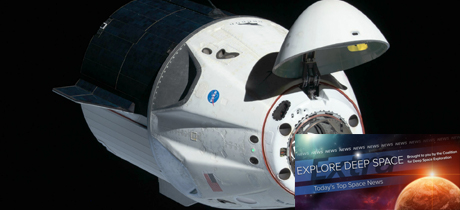In Today’s Deep Space Extra… Testing continues for NASA’s first Artemis moon mission. NASA and the European Space Agency (ESA) make progress in agreements to develop a lunar orbiting, human tended Gateway and to bring samples of the Martian surface back to Earth. NASA gives the unfolding SpaceX Demo-2 mission to the International Space Station (ISS) high marks so far.
Human Space Exploration
SLS testing continues for NASA’s first Artemis Moon mission
Ameicaspace.com (6/24): While a pandemic and social unrest have swept the nation, NASA is staying focused on their goal of returning America to the moon with the Artemis missions. Recently, the two solid rocket boosters for the agency’s giant Space Launch System (SLS) rocket were shipped to Kennedy Space Center (KSC) in Florida, while engineers at Stennis Space Center in southern Mississippi continue putting the core stage through a series of ‘Green Run’ tests which will continue throughout the summer and culminate with a full-duration 8-minute test fire of the mammoth rocket later this year.
ESA council approves lunar Gateway, Mars sample return MOUs with NASA
Parabolicarc.com (6/24): During a meeting of the European Space Agency (ESA) council on Wednesday, the policy makers approved a memoranda of understanding (MOU) with NASA regarding cooperation in the development of a lunar orbiting, human tended Gateway and a strategy for returning samples of Martian rock and soil that are to be gathered and cached by NASA’s Perseverance Mars 2020 rover. The rover is currently planned to launch no earlier than July 22 to reach the Red Planet’s Jezero Crater, a dry lake and stream delta, in February to begin a two year mission seeking evidence the landing site was habitable billions of years ago. A joint mission to return the samples to Earth could launch in 2026.
After nearly a month in space, NASA seems really happy with Crew Dragon
Ars Technica (6/24): During a news briefing on Wednesday, two top NASA managers stated they are pleased with the performance so far of the SpaceX Demo-2 spacecraft, which launched from Florida’s space coast on May 30 and docked to the International Space Station (ISS) on May 31, delivering veteran NASA astronauts Bob Behnken and Doug Hurley. The spacecraft is slated to remain parked at the orbital outpost into early August, allowing Behken to join NASA’s Chris Cassidy, the Space Station commander, for a series of spacewalks. The excursions are to begin Friday and involve an upgrade of the Station’s external solar power system batteries. Kenneth Todd, NASA’s Space Station deputy program manager, was joined by Steve Stich, NASA’s Commercial Crew Program manager, for the briefing.
Space Science
Launch of NASA’s Perseverance Mars rover delayed to July 22
Coalition Member in the News – United Launch Alliance
Spaceflightnow.com (6/24): Launch of NASA’s Perseverance Mars 2020 rover has been delayed by two days to no earlier than July 22 due to a ground equipment issue at NASA’s Payload Hazardous Servicing Facility (PHSF) the agency said Wednesday. The launch window, which originally opened July 17, closes on August 11, with a possible extension to August 15. Missing the window during which the Earth and Mars are favorably aligned to land at the red planet on February 18, would result in a costly 26 month delay. Once at Mars, the rover will carry out a complex mission that includes collection of rock core samples for eventual return to Earth on a future mission.
Heat gave Jupiter’s icy moon Europa layers. That may be good news for the search for life
Space.com (6/24): A NASA Jet Propulsion Laboratory (JPL) research team that combed through data gathered by NASA’s Galileo mission has determined that Jupiter’s ice and ocean covered moon Europa formed in a thermal environment that produced a layered interior subsurface ocean. The findings presented this week before the Goldschmidt Conference contribute to the prospect that Europa may host potentially habitable environments. Launched aboard a NASA space shuttle in 1989, Galileo reached Jupiter in late 1995, where it orbited until September 2003. NASA is preparing the Europa Clipper mission for launch in the mid-2020’s to further investigate Europa’s habitability.
Others News
NASA to rename headquarters for Mary W. Jackson, agency’s first female African American engineer
Washington Post (6/24): NASA’s Washington headquarters is being named in honor of Mary W. Jackson, NASA first African-American female engineer. A mathematician and aerospace engineer, Jackson joined NASA’s predecessor, the National Advisory Committee for Aeronautics and through her contributions became one of the black women featured in the recent film “Hidden Figures” that traced the agency’s struggles with racism. She departed NASA in 1979 and passed away in 2005. Jackson was recognized for her contributions to NASA’s early human spaceflight with a posthumous award of the Congressional Gold Medal in 2019.
Campaign to rename Stennis Space Center kicks off
Spacepolicyonline.com (6/24): In addition to naming NASA’s Washington headquarters in honor of the late Mary W. Jackson, an African American mathematician and aerospace engineer from the space agency’s early days, a campaign is underway to rename NASA’s Stennis Space Center in Mississippi, which was named for John Stennis, a former U.S. senator and segregationist. The effort is led by William Pomerantz, co-founder of the Brooke Owens Fellowship and Virgin Orbit’s vice president for special projects.
Griffin’s departure stirs questions about the future of the Space Development Agency
SpaceNews.com (6/24): Earlier this week, Mike Griffin, the former NASA administrator and Department of Defense (DoD) Under Secretary for Research and Engineering, and his deputy, Lisa Porter, announced their July 10 departure, to enter the private sector. The timing has raised questions within the Pentagon and aerospace industry about the future of the Space Development Agency, which was initiated just 15 months ago, something Griffin worked hard to stand up and considered a “personal cause.”

